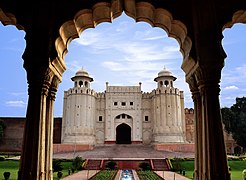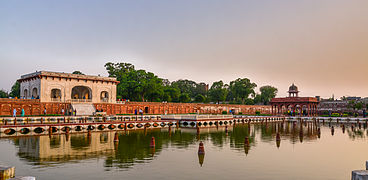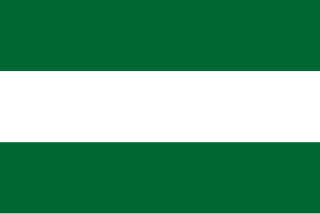
The Durrani Empire, or the Afghan Empire, also known as the Sadozai Kingdom, was an Afghan empire founded by the Durrani tribe of Pashtuns under Ahmad Shah Durrani in 1747, which spanned parts of Central Asia, the Iranian plateau, and the Indian subcontinent. At its peak, it ruled over present-day Afghanistan, much of Pakistan, parts of northeastern and southeastern Iran, eastern Turkmenistan, and northwestern India. Next to the Ottoman Empire, the Durrani Empire is considered to be among the most significant Islamic empires of the second half of the 18th century.

Multan is a city in Punjab, Pakistan, located on the bank of river Chenab. It is one of the five largest urban centres of Pakistan in 2024 and serves as the administrative centre of Multan Division. A major cultural, religious and economic centre of Punjab region, Multan is one of the oldest inhabited cities of Asia, with a history stretching deep into antiquity.

The Lahore Fort is a citadel in the city of Lahore in Punjab, Pakistan. The fortress is located at the northern end of the Walled City of Lahore and spreads over an area greater than 20 hectares. It contains 21 notable monuments, some of which date to the era of Emperor Akbar. The Lahore Fort is notable for having been almost entirely rebuilt in the 17th century, when the Mughal Empire was at the height of its splendor and opulence.

Mughal architecture is the type of Indo-Islamic architecture developed by the Mughals in the 16th, 17th and 18th centuries throughout the ever-changing extent of their empire in the Indian subcontinent. It developed from the architectural styles of earlier Muslim dynasties in India and from Iranian and Central Asian architectural traditions, particularly Timurid architecture. It also further incorporated and syncretized influences from wider Indian architecture, especially during the reign of Akbar. Mughal buildings have a uniform pattern of structure and character, including large bulbous domes, slender minarets at the corners, massive halls, large vaulted gateways, and delicate ornamentation; examples of the style can be found in modern-day Afghanistan, Bangladesh, India and Pakistan.

Ahmad Shah Bahadur, also known as Mirza Ahmad Shah or Mujahid-ud-Din Ahmad Shah Ghazi, was the fourteenth Mughal emperor, born to Emperor Muhammad Shah. He succeeded his father to the throne in 1748, at the age of 22. When Ahmed Shah Bahadur came to power, the Mughal Empire started to decline. Furthermore, his administrative weakness eventually led to the rise of the usurping Imad-ul-Mulk.

Raghunathrao Bhat, also known as Ragho Ballal or Raghoba Dada, was the younger son of Peshwa Bajirao I who served as the 11th Peshwa of the Maratha Confederacy for a brief period from 1773 to 1774.

Shahryar Mirza was the fifth and youngest son of the Mughal emperor Jahangir. At the end of Jahangir's life and after his death, Shahryar made an attempt to become emperor, planning, supported and conspiracy by his one in influence and all-powerful stepmother Nur Jahan, who was also his mother-in-law. The succession was contested, though Shahryar exercised power, based in Lahore, from 7 November 1627 to 19 January 1628, but like his father, he allowed Nur Jahan to run the affairs and consolidate his reign, but she did not succeed, and he was defeated and was killed at the orders of his brother Khurram, better known as Shah Jahan once he took the throne. Shahryar would have been the fifth Mughal Emperor, but is usually not counted in the list of Mughal Emperors.
Multan in Punjab province of Pakistan is one of the oldest cities of South Asia, though its exact age has yet to be determined. Multan is known for its rich ancient heritage and historic landmarks. Multan was the capital and largest city of Punjab region in late ancient and most of the medieval era. Multan region was centre of many civilizations in its 5 millenia old history, and witnessed warfare across millennia because of its location on a major invasion route between South and Central Asia.
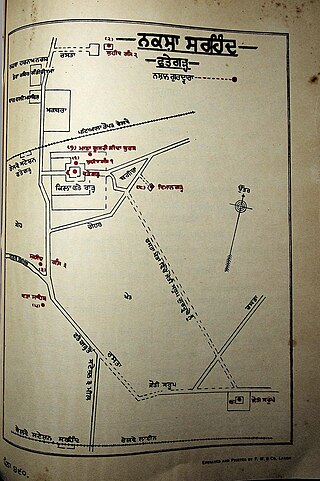
Sirhind is the older name of Fatehgarh Sahib, a city and Sikh pilgrimage site in Punjab, India. It is situated on the Delhi to Lahore Highway. It has a population of about 60,851 . It is now a district headquarters in the state of Punjab; the name of the district is Fatehgarh Sahib.

Feroze Jung III or Nizam Shahabuddin Muhammad Feroz Khan Siddiqi Bayafandi also known by his sobriquet Imad-ul-Mulk, was the grand vizier of the Mughal Empire when it was under Maratha suzerainty, making them the de facto rulers.

The Afghan–Sikh wars spanned from 1748 to 1837 in the Indian subcontinent, and saw multiple phases of fighting between the Durrani Empire and the Sikh Empire, mainly in and around Punjab region. The conflict's origins stemmed from the days of the Dal Khalsa, and continued after the Emirate of Kabul succeeded the Durrani Empire.
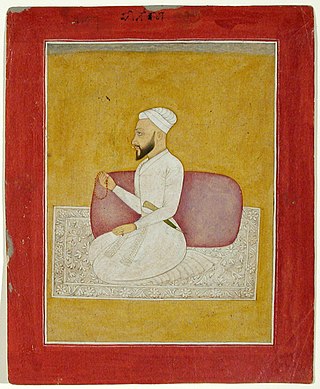
Adina Beg Khan was a Punjabi Muslim general and administrator who served as the last governor of the Punjab region of the Mughal Empire, including the provinces of Lahore and of Multan. He defeated Afghans after rising to power and was recognised as the Nawab of Punjab by Mughal emperor Alamgir II, who also gave him title of Jang Bahadur.

The Afghan–Maratha War was fought between the Afghan Empire under Ahmad Shah Durrani and the Maratha Confederacy and the Sikh Confederacy between 1758 and 1761. It took place in north-west India, primarily the region around Delhi and Punjab.

Timur Shah Durrani, also known as Timur Shah Abdali or Taimur Shah Abdali was the second ruler of the Afghan Durrani Empire, from November 1772 until his death in 1793. An ethnic Pashtun, he was the second eldest son of Ahmad Shah Durrani.

Ahmad Shah Durrani, the founder of the Durrani Empire, invaded Indian subcontinent for eight times between 1748 and 1767, following the collapse of Mughal Empire in the mid-18th century. His objectives were met through the raids and deepened the political crisis in India.

Mughlani Begum also known as Murad Begum, ruled Punjab from Lahore for a few months in 1753. She was known for playing her friends and foes against each other for her personal gains. She was the wife of Moin-ul-Mulk, who was Governor of the Subah of Lahore from 1748 to 1753, and who had endeared himself to Ahmed Shah Abdali, the Emperor of Afghanistan.
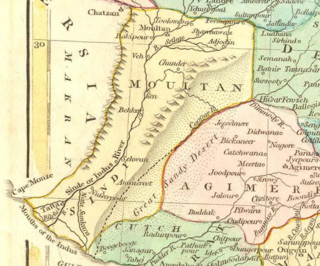
The Subah of Multan was a Subah (province) of the Mughal Empire, one of the original twelve provinces of Mughals, encompassing the southern Punjab region, stretching towards parts of Khyber, Central Punjab and Balochistan, bordering Kandahar Province and the Persian Safavid Empire. It was one of the largest and important provinces of Mughal Empire.

Mian-Moin-ul-Mulk, also known by his title Mir Mannu, was the Mughal and later Durrani governor of the Punjab between 1748 and 1753.

Sa'adullah Khan, also spelled Sadullah Khan was the Grand Vizier and Vakil-I-Mutlaq of the Mughal Empire during the reign of Shah Jahan I.
The Battle of Lahore was fought between Afghan forces under Ahmad Shah Durrani and Mughal forces under Shah Nawaz on 11 January 1748. Zakriya Khan, the Mughal Governor of Lahore, died in 1745 and was succeeded by his son, Yahya Khan. Yahya Khan's governorship over Lahore was soon challenged by his brother, Shah Nawaz, who was the governor of Multan. This resulted in a war between the two brothers, lasting from November 1746 to March 1747. The war was won by Shah Nawaz, who soon usurped the governorship of Lahore. Shah Nawaz would go on to appoint Kaura Mal as his diwan and recognized Adina Beg Khan as the Faujdar of the Jalandhar Doaba. Shah Nawaz used his captive brother as a bargaining tool in order to get recognition from the Delhi government. However, following Yahya Khan's escape from captivity, Shah Nawaz sought help from abroad. He turned to Ahmad Shah Durrani, who had just taken the city of Kabul from the Mughals. Ahmad Shah agreed to assist him, and left Peshawar in December 1747. However, Shah Nawaz then changed his allegiance back to the Mughals, and fought a battle against Ahmad Shah near Lahore. The battle was won by the Afghans, who briefly occupied the city of Lahore.









